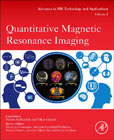
Quantitative Magnetic Resonance Imaging
Seiberlich, Nicole
Gulani, Vikas
Campbell, Adrienne
Sourbron, Steven
Doneva, Mariya Ivanova
Calamante, Fernando
Hu, Houchun Harry
Quantitative Magnetic Resonance Imaging is a 'go-to' reference for methods and applications of quantitative magnetic resonance imaging, with specific sections on Relaxometry, Perfusion, and Diffusion. Each section will start with an explanation of the basic techniques for mapping the tissue property in question, including a description of the challenges that arise when using these basic approaches. For properties which can be measured in multiple ways, each of these basic methods will be described in separate chapters. Following the basics, a chapter in each section presents more advanced and recently proposed techniques for quantitative tissue property mapping, with a concluding chapter on clinical applications. The reader will learn: The basic physics behind tissue property mapping How to implement basic pulse sequences for the quantitative measurement of tissue properties The strengths and limitations to the basic and more rapid methods for mapping the magnetic relaxation properties T1, T2, and T2* The pros and cons for different approaches to mapping perfusion The methods of Diffusion-weighted imaging and how this approach can be used to generate diffusion tensor maps and more complex representations of diffusion How flow, magneto-electric tissue property, fat fraction, exchange, elastography, and temperature mapping are performed How fast imaging approaches including parallel imaging, compressed sensing, and Magnetic Resonance Fingerprinting can be used to accelerate or improve tissue property mapping schemes How tissue property mapping is used clinically in different organs Structured to cater for MRI researchers and graduate students with a wide variety of backgroundsExplains basic methods for quantitatively measuring tissue properties with MRI - including T1, T2, perfusion, diffusion, fat and iron fraction, elastography, flow, susceptibility - enabling the implementation of pulse sequences to perform measurementsShows the limitations of the techniques and explains the challenges to the clinical adoption of these traditional methods, presenting the latest research in rapid quantitative imaging which has the possibility to tackle these challengesEach section contains a chapter explaining the basics of novel ideas for quantitative mapping, such as compressed sensing and Magnetic Resonance Fingerprinting-based approaches INDICE: 1. Introduction 2. MRI Biomarkers 3. Physical and Physiological Principles of T1 and T2 4. T1/T1p mapping methods 5. T2/T2* mapping methods 6. Multi-Property Methods 7. Specialized Mapping Methods in the Heart 8. Advances in signal processing for relaxometry 9. Applications in the Brain 10. Applications in MSK 11. Applications in the Body 12. Applications in the Heart 13. Physical and Physiological Principles of Perfusion & Permeability 14. ASL: basic physics, pulse seq, modeling 15. DCE: basic physics, pulse seq, modeling 16. DSC: basic physics, pulse seq, modeling 17. Applications of quantitative perfusion and permeability in the Brain 18. Applications of quantitative perfusion and permeability in the Heart 19. Applications of quantitative perfusion and permeability in the Body 20. Physical and Physiological principles of diffusion 21. Acquisition of Diffusion MRI data 22. Modelling fibre orientations using diffusion MRI 23. Diffusion MRI fibre tractography 24. Measuring microstructure using diffusion MRI 25. Diffusion MRI applications in the Brain 26. Physical and Physiological Properties of Fat 27. Physical and Physiological Properties of Iron 28. Fat mapping techniques, basics to advancedIron mapping techniques and applications, basics to advanced, and future directions 29. Applications and Future directions for quantitative fat imaging 30. Electro-magnetic Property Mapping 31. Exchange Mapping 32. Temperature Mapping 33. Motion Encoding 34. Quantification of Flow 35. Hyperpolarized MRI
- ISBN: 978-0-12-817057-1
- Editorial: Academic Press
- Encuadernacion: Rústica
- Páginas: 780
- Fecha Publicación: 01/10/2020
- Nº Volúmenes: 1
- Idioma: Inglés
